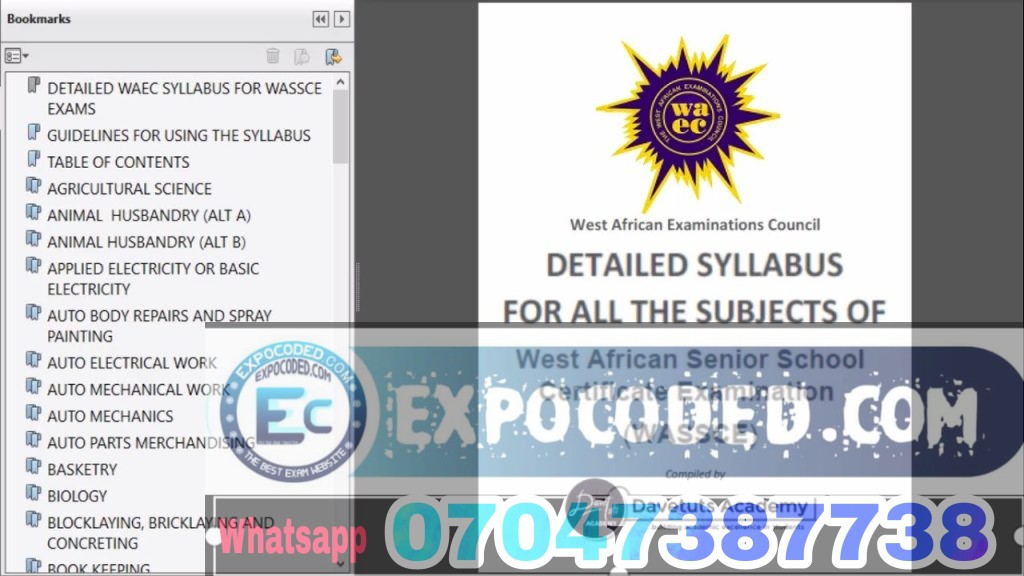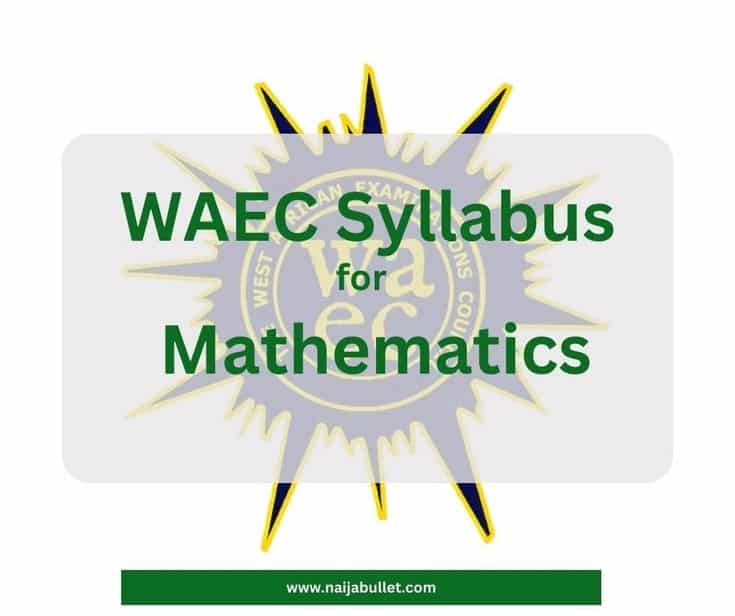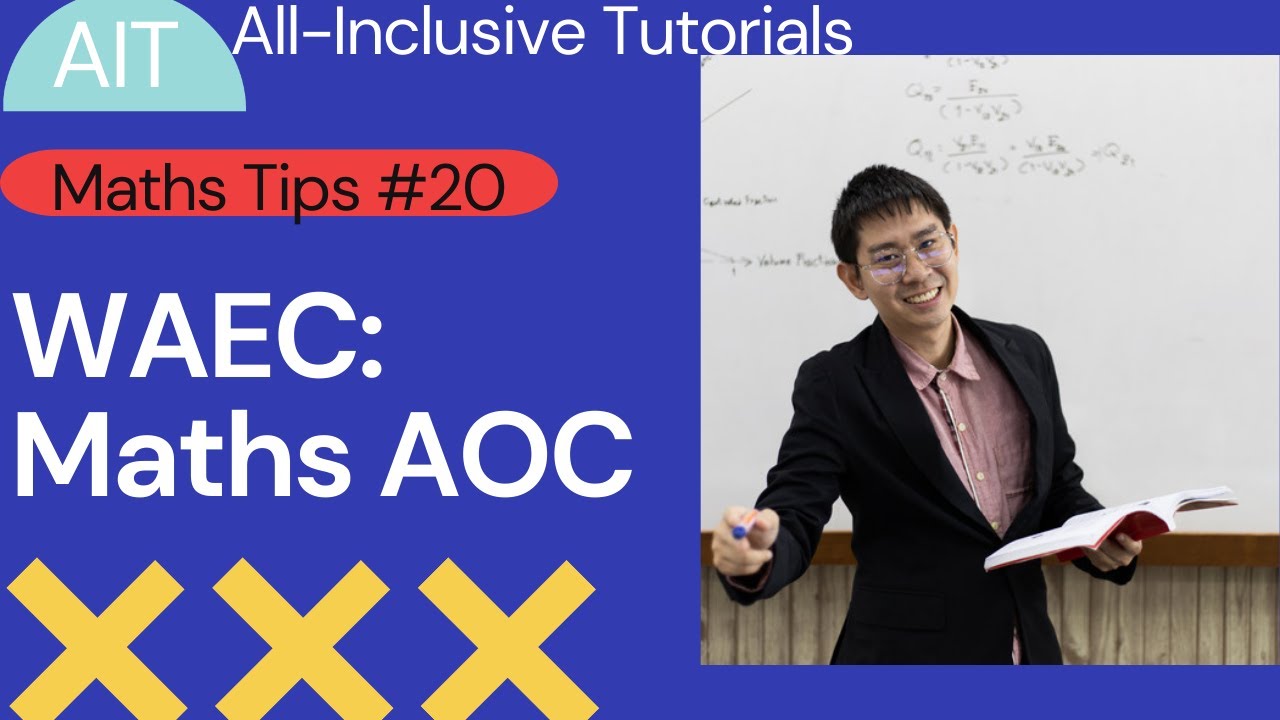WAEC Syllabus for Physical Education 2024/2025
Are you preparing for the West African Examination Council (WAEC) exam in 2024/2025? Do you want to ace the Physical Education subject and get a good grade? If yes, then you need to study the WAEC syllabus for Physical Education and follow the recommended textbooks.
In this blog post, I will share with you everything you need to know about the WAEC syllabus for Physical Education, including the areas of concentration, the aim and objectives, the list of topics, and the list of all the WAEC subjects syllabus. I will also answer some frequently asked questions and provide some tips on how to study effectively for the exam.

What is WAEC Syllabus for Physical Education?
The WAEC syllabus for Physical Education is a document that contains the topics, concepts, and skills that you are expected to learn and demonstrate in the Physical Education exam. It also outlines the aims and objectives, the format and structure, and the marking scheme of the exam.
The WAEC syllabus for Physical Education is designed to assess your understanding of movement activities and the relationships between movement and concepts from biological, physical, and social sciences. It also tests your skills in basic motor activities, fitness, maintenance, and self-awareness. Moreover, it evaluates your appreciation of the role of movement and physical activity in human development, and your understanding of physical activity and exercise as tools for health and wellness promotion.
The WAEC syllabus for Physical Education is based on the UNESCO charter on physical education and sports, which recognizes the inalienable right of every child to participate in physical activity irrespective of race, gender, religion, and physical state. The syllabus aims to provide you with worthwhile skills needed for participation in physical activity, sports, and recreational activities, as well as the potential carry-over value of healthful living.
Why is WAEC Syllabus for Physical Education Important?
The WAEC syllabus for Physical Education is important because it serves as a guide for you to know what to study and what to expect in the exam. It helps you to focus on the relevant topics and avoid wasting time on irrelevant or outdated information. It also helps you to understand the objectives and expectations of the examiners, and to prepare accordingly.
Studying the WAEC syllabus for Physical Education is necessary for your exam preparation. It will help you to improve your knowledge, skills, and confidence in the subject. It will also help you to score high marks and achieve your academic goals.
How to Download WAEC Syllabus for Physical Education?
You can download the WAEC syllabus for Physical Education from the official website of the West African Examination Council (1). You can also access it from other reliable sources, such as educational websites, blogs, and forums. However, you should always verify the authenticity and currency of the syllabus before using it.
To download the WAEC syllabus for Physical Education, follow these steps:
- Go to the WAEC website (1) and click on the “Syllabus” tab on the menu bar.
- Select the year and the subject of your choice from the drop-down menus.
- Click on the “Download” button and save the PDF file on your device.
- Open the file and read the syllabus carefully.
Alternatively, you can click on this link to download the WAEC syllabus for Physical Education 2024/2025 directly: 2.
What are the Areas of Concentration in WAEC Syllabus for Physical Education?
The areas of concentration in WAEC syllabus for Physical Education are the main topics and subtopics that you should focus on while studying for the exam. They cover the core aspects of the subject and reflect the objectives and scope of the syllabus.
The areas of concentration in WAEC syllabus for Physical Education are:
- Principles and Philosophy of Physical Education
- National and International Sports Competitions
- Basic Human Anatomy and Physiology in Relation to Physical Activities
- The Practice of Athletics, Games, and Dance
- Physical Fitness and Conditioning
- Nutrition, Drug, and Sports
- Sports Administration
Each area of concentration has several subtopics that explain the specific concepts and skills that you should learn and practice. You can find the detailed breakdown of the areas of concentration and the subtopics in the WAEC syllabus for Physical Education PDF file.
What are the Aim and Objectives of WAEC Syllabus for Physical Education?
The aim and objectives of WAEC syllabus for Physical Education are the intended outcomes and benefits of studying the subject and taking the exam. They describe what you should be able to do and demonstrate after completing the syllabus and the exam.
The aim and objectives of WAEC syllabus for Physical Education are:
- To enable you to acquire the understanding of movement activities and the relationships between movement and concepts from biological, physical, and social sciences.
- To enable you to develop skills needed in basic motor activities, fitness, maintenance, and self-awareness.
- To enable you to appreciate the role of movement and physical activity in human development.
- To enable you to understand physical activity and exercise as tools for health and wellness promotion.
What is the Format and Structure of WAEC Syllabus for Physical Education?
The format and structure of WAEC syllabus for Physical Education are the way the exam is organized and presented. They include the duration, the number of questions, the types of questions, the marks allocation, and the instructions for the exam.
The format and structure of WAEC syllabus for Physical Education are:
- The exam consists of two papers: Paper 1 and Paper 2.
- Paper 1 is a theory paper that lasts for 2 hours and 30 minutes. It contains 50 multiple-choice questions and 10 essay questions. You are required to answer all the multiple-choice questions and any five of the essay questions. The paper carries 100 marks.
- Paper 2 is a practical paper that lasts for 2 hours. It contains 10 practical tasks that test your skills in athletics, games, and dance. You are required to perform any six of the tasks. The paper carries 100 marks.
- The total marks for the exam are 200 marks.
What are the Recommended Textbooks for WAEC Syllabus for Physical Education?
The recommended textbooks for WAEC syllabus for Physical Education are the books that are approved and endorsed by the West African Examination Council as suitable and relevant for the subject. They contain the content and the exercises that match the syllabus and the exam.
The recommended textbooks for WAEC syllabus for Physical Education are:
- Adedeji, J. A. and Oyebanji, J. O. (2004). Essential Physical and Health Education for Senior Secondary Schools. Ibadan: University Press Plc.
- Anyakoha, E. U. (2007). Physical Education and Sports for Senior Secondary Schools. Onitsha: Africana First Publishers Ltd.
- Asaolu, A. (2005). Handbook on Teaching Physical Education. Ibadan: Heinemann Educational Books Plc.
- Ogunjimi, L. O. and Oyebanji, J. O. (2004). A Comprehensive Text on Physical and Health Education for Colleges and Universities. Ibadan: University Press Plc.
You can also use other textbooks that cover the syllabus and the exam, as long as they are accurate, up-to-date, and reliable.
What are the List of Topics in WAEC Syllabus for Physical Education?
The list of topics in WAEC syllabus for Physical Education are the specific subtopics that you should study and master for the exam. They are derived from the areas of concentration and the subtopics in the syllabus.
The list of topics in WAEC syllabus for Physical Education are:
- Principles and Philosophy of Physical Education
- Meaning, scope, and objectives of physical education
- Historical development of physical education
- Philosophical foundations of physical education
- Sociological and psychological aspects of physical education
- Professional ethics and code of conduct in physical education
- National and International Sports Competitions
- Meaning, types, and purposes of sports competitions
- National sports competitions in Nigeria
- International sports competitions and organizations
- Rules, regulations, and officiating of selected sports
- Awards and honours in sports
- Basic Human Anatomy and Physiology in Relation to Physical Activities
- Meaning and importance of anatomy and physiology in physical education
- Structure and functions of the skeletal system
- Structure and functions of the muscular system
- Structure and functions of the respiratory system
- Structure and functions of the circulatory system
- Structure and functions of the nervous system
- Structure and functions of the endocrine system
- Structure and functions of the digestive system
- Structure and functions of the urinary system
- Structure and functions of the reproductive system
- Effects of physical activities on the human body systems
- The Practice of Athletics, Games, and Dance
- Meaning and classification of athletics, games, and dance
- Skills and techniques of selected track and field events
- Skills and techniques of selected team and individual games
- Skills and techniques of selected folk, social, and creative dances
- Safety measures and precautions in athletics, games, and dance
- Equipment and facilities for
Here is a summary and some FAQs about the WAEC syllabus for Physical Education 2024/2025:
- The WAEC syllabus for Physical Education is a document that communicates information about the course content, objectives, and examination scheme for the subject.
- The syllabus is designed to assess the candidates’ understanding of movement activities, skills in basic motor activities, appreciation of the role of physical activity in human development, and knowledge of physical activity and exercise as tools for health and wellness promotion.
- The syllabus covers topics such as principles and philosophy of physical education, national and international sports competitions, basic human anatomy and physiology, the practice of athletics, games and dance, physical fitness and conditioning, nutrition, drug and sports, and sports administration.
- The examination scheme consists of two papers: Paper 1 (theory) and Paper 2 (practical). Paper 1 is a 2-hour paper that contains 50 multiple-choice questions and 10 essay questions. Paper 2 is a 2-hour paper that tests the candidates’ practical skills in three out of six activities: athletics, games, dance, gymnastics, swimming, and self-defense.
FAQs:
- Q: Where can I download the WAEC syllabus for Physical Education?
- A: You can download the WAEC syllabus for Physical Education from various online sources, such as this one
- Q: What are the recommended textbooks for the WAEC syllabus for Physical Education?
- A: Some of the recommended textbooks for the WAEC syllabus for Physical Education are:
- Ajisafe, O. (2010). Essential Physical Education for Senior Secondary Schools. Lagos: Tonad Publishers.
- Anyanwu, E. (2008). Exam Focus Physical Education for WASSCE and SSCE. Ibadan: University Press Plc.
- Ogunjimi, L. et al (2000). Comprehensive Certificate Physical and Health Education. Ibadan: Evans.
- Q: How can I prepare for the WAEC syllabus for Physical Education?
- A: To prepare for the WAEC syllabus for Physical Education, you should:
- Study the syllabus thoroughly and understand the objectives and expectations of the course.
- Read the recommended textbooks and other relevant materials to gain comprehensive knowledge of the subject matter.
- Practice the past questions and answers to familiarize yourself with the examination format and style.
- Engage in regular physical activities and exercises to improve your fitness and skills.
- Follow the instructions and guidelines of your teacher or tutor for the practical sessions.

